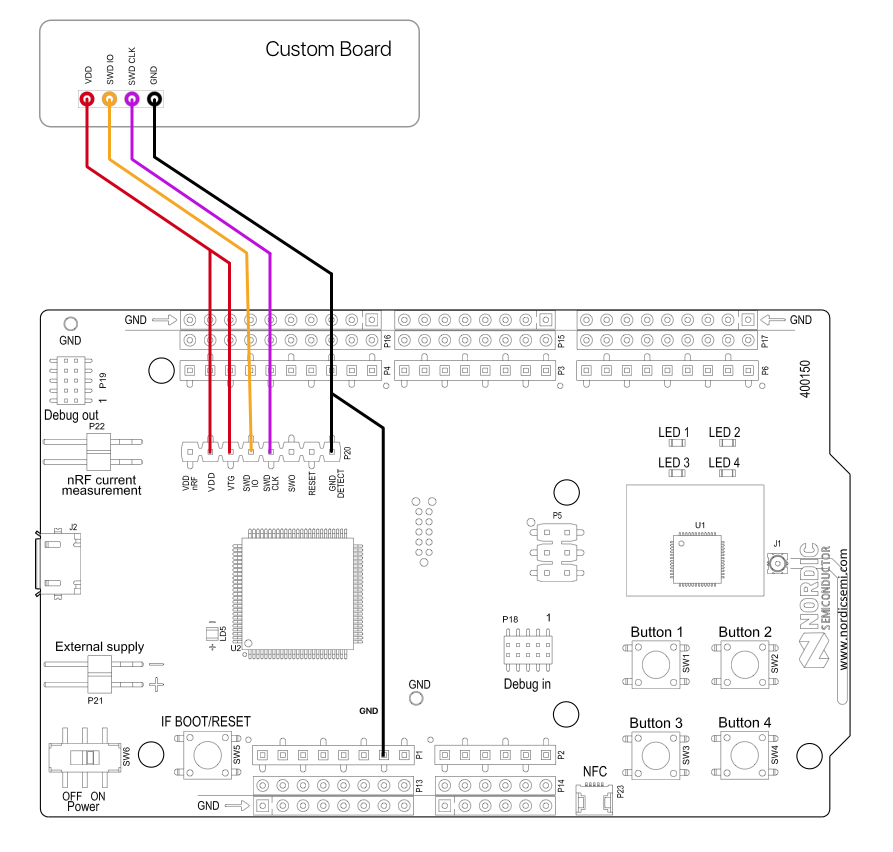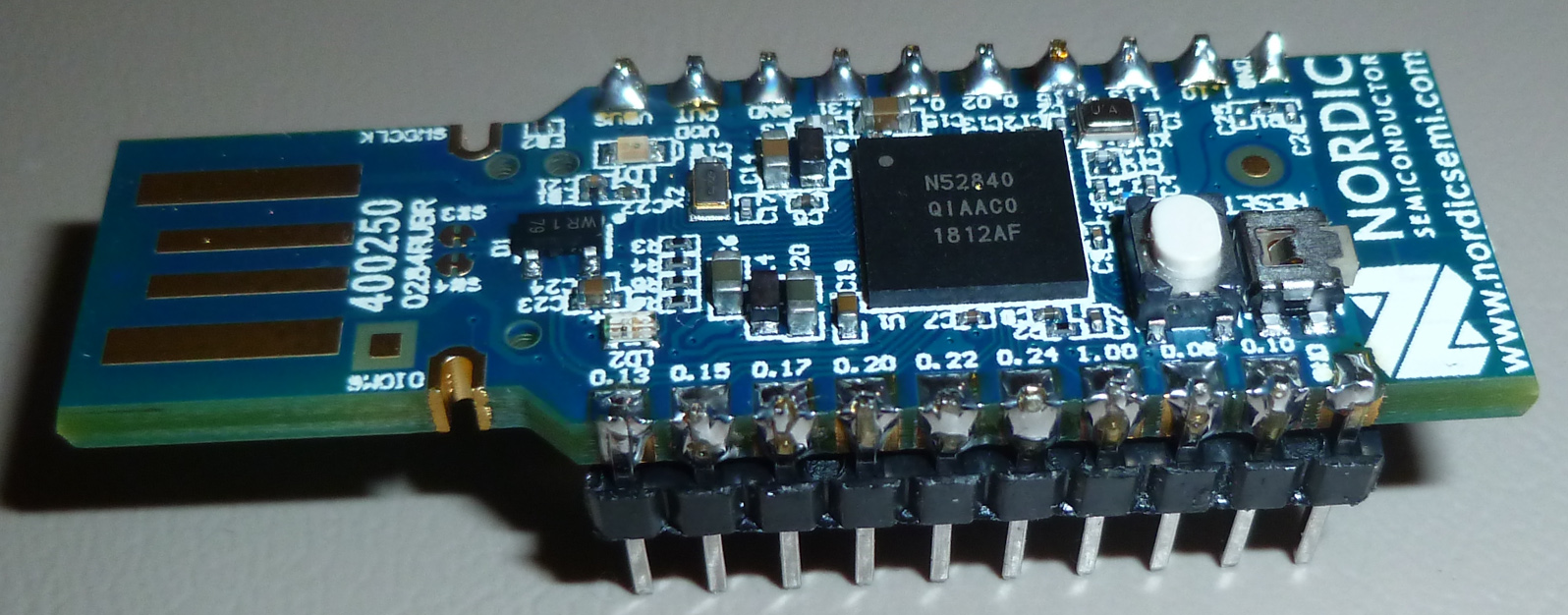Everything nRF52840
-
Wait, what? The nRF52840 can now act as a Zigbee device too??
So I could make Arduino projects that talk Zigbee?
@alowhum Well, 802.15.4 for sure. I already did it, as I reported earlier. Beyond that, there's no native on-chip support for Zigbee per se. Maybe they confused it with zigbee? https://www.electronicdesign.com/what-s-difference-between/what-s-difference-between-ieee-802154-and-zigbee-wireless
That said, someone could certainly write a zigbee on top of it. It's meant for stuff like that. I imagine Thread is already written on top of it.
Anyway, I suspect that the amplified nRF52840 modules will be as good as it gets for quite some time and will remain relevant for years to come. The long wait is finally over!
-
By the way, I now have the wireless FORTH REPL working on the same nRF52840-dongle as in the OP of this thread: https://github.com/rabbithat/nRF52840-Dongle_hex/blob/master/README.md
I can plug the dongle into any USB port to power it, and with the wireless REPL the experience is exactly the same as if I had a wired serial connection to the dongle. I can interact with the REPL, start programs, load code or updates, and/or debug--all wirelessly. If you want to try it, I have getting started instructions in the github repository.
-
Someone know if exist a usb nRF52840-dongle (with external antenna ) to plug into a raspberry to scan nearby tag?
-
@blademckain The Micro:bit comes close.
-
The new Arduino Nano 33 BLE is going to use the nrf52840. It will be interesting to see how support for the nrf52840 evolves in the Arduino environment.
-
The new Arduino Nano 33 BLE is going to use the nrf52840. It will be interesting to see how support for the nrf52840 evolves in the Arduino environment.
-
Arduino Nano 33 BLE code is coming out. It's going to be based on MBED. Here's a discussion on the Arcuino Blog:
https://blog.arduino.cc/2019/07/31/why-we-chose-to-build-the-arduino-nano-33-ble-core-on-mbed-os/I think it is interesting that no one has updated Sandeep Mistry's code for the NRF52840. Since it has been so long, I'm guessing this is not an easy task.
-
Arduino Nano 33 BLE code is coming out. It's going to be based on MBED. Here's a discussion on the Arcuino Blog:
https://blog.arduino.cc/2019/07/31/why-we-chose-to-build-the-arduino-nano-33-ble-core-on-mbed-os/I think it is interesting that no one has updated Sandeep Mistry's code for the NRF52840. Since it has been so long, I'm guessing this is not an easy task.
-
Someone may get some reuse out of this. I've made a 3d printed prototyping rig for the NRF52840 DK board as part of my MySensors adventures....
https://www.thingiverse.com/thing:3836487


-
Arduino Nano 33 BLE code is coming out. It's going to be based on MBED. Here's a discussion on the Arcuino Blog:
https://blog.arduino.cc/2019/07/31/why-we-chose-to-build-the-arduino-nano-33-ble-core-on-mbed-os/I think it is interesting that no one has updated Sandeep Mistry's code for the NRF52840. Since it has been so long, I'm guessing this is not an easy task.
@nagelc I think Sandeep Mistry is working on new arduino core, based on mbed. As you can see he is titled as "Senior Software Engineer at Arduino" here. So I guess Mysensors community would need to move to new core eventually, or to fork Sandeep's core and develop it alone. I would prefer the first choice.
-
@monte
I remember in first place they mentioned apache mynewt a while ago, but finally they are moving to mbed.. still nice to hear. I think this new arduino/mbed core has not everything yet for running MySensors, that needs some work on proprietary rf.., whereas there are other working cores. At least for short-mid term. There are so much nice things to improve or add on todolist.
Team knows about new mcus, new cores etc :nerd_face: what's missing is time, resources vs real life and projects! -
@monte
I remember in first place they mentioned apache mynewt a while ago, but finally they are moving to mbed.. still nice to hear. I think this new arduino/mbed core has not everything yet for running MySensors, that needs some work on proprietary rf.., whereas there are other working cores. At least for short-mid term. There are so much nice things to improve or add on todolist.
Team knows about new mcus, new cores etc :nerd_face: what's missing is time, resources vs real life and projects!@scalz With official support from arduino and massive amount of chinese clone boards and much more powerful hardware I think in a year new nano board can become a new standard. Not to mention that single board which already has everything to work with mysensors is something many people where looking for for years.
I understand the time constrains, and am always thankful for a dev's work for community's good :) -
@monte sure would be nice, no need to argue on this, about a standard. (still not sure imho if 2.4g would be best choice). I'm wondering if adafruit will give up on all the work they made on their custom core too (I imagine they have no hurry, and wait to see if that'll be promising).
let's see what will happen. and perhaps next year there will be new better mcus again, almost sure :grin: -
@neverdie I admit that I also powered the module via the DK because it takes less than 20mA. I used this connection description:

But I'll try to use a complete an external PS next time and see if it makes a difference.@heinzv Sorry to cut-in with an unrelated comment, but can you tell me how or from where you got this nice schematic diagram? I am looking for one that has other cards such as Raspberry Pi and TI cards for an architectural diagram
Cheers
-
@heinzv Sorry to cut-in with an unrelated comment, but can you tell me how or from where you got this nice schematic diagram? I am looking for one that has other cards such as Raspberry Pi and TI cards for an architectural diagram
Cheers
@amine-alami what nice schematic diagram are you refering to? I'm looking at this thread very sporadically.
-
After waiting almost a year for the dust to clear, it seems that there are now roughly two leading platforms at the moment that either have or may get good software support:
- The Adafruit nRF52840 feather: https://www.adafruit.com/product/4062
which Adafruit either has or is making Arduino compatible. - Possibly the Arduino Nano 33 BLE: https://store.arduino.cc/usa/nano-33-ble
and/or https://store.arduino.cc/usa/nano-33-ble-sense
for which, ironically, Arduino has chosen to adopt using mbed as the core software techology.
In other words, it appears that Adafruit has become more Arduino than Arduino!
There are also some "particle" boards that are hybrids:
https://www.cnx-software.com/2018/02/14/particle-unveils-three-nrf52840-bluetooth-5-boards-argon-wifi-boron-lte-and-xenon-particle-mesh-technology/
I had thought these would necessarily be more expensive, but right now the Xenon board is selling at $15, which is almost half the price of either the Adafruit or the Arduino boards:
https://www.amazon.com/s?k=particle+xenon&i=electronics&ref=nb_sb_noss_1
Are the particles easy to program and perform OTA updates? I have no experience with them. They're pushing a subscription service if you have more than ten or so of them, so I suppose the true cost could be higher if you go "all in" on them. On the other hand, if you happen to want/need whatever their cloud service is, at least you'd be getting some kind of value for your subscription money. I suspect that, at the moment, it may be the easier to do OTA updates with particle than the first two, if only because it needs to be good if they are to justify their service fee. Their Photon board (which is a wi-fi only device) has gotten mostly favorable reviews on Amazon. On Photon the subscription fee doesn't kick in until you have more than 100 photons, which sounds a lot less confining the the 10+ units of Argon or Xenon. Unfortunately, it sounds as though it's not low power enough for battery powered nodes: https://www.youtube.com/watch?v=68N67ZVxTZ0 A 7.5ma deep sleep sounds stupidly high to me. What were they thinking?In summary, the Adafruit nodes sound best to me at this point in time. The Arduino nodes might catch up with the adafruit if enough people buy/develop for them. Time will tell. Sadly, Particle may be DOA unless they have a trick up their sleeve that I don't know about.
- The Adafruit nRF52840 feather: https://www.adafruit.com/product/4062
-
I think adafruit core is nice, and they added freertos which is a nice touch too. So, in case, I can easily reuse some modules I wrote for esp32 projects (which is freertos based too, out of he box)
Good to know, it's not perfect, both cores, nrf5 adafruit or arduino-mbed, unfortunately miss some sdk files..
I like Adafruit core so far, but Segger IDE with full sdk support is very convenient, because spending time in arduino cores linking missing libs etc is such waste of time, vs coding fun features..
-
I think adafruit core is nice, and they added freertos which is a nice touch too. So, in case, I can easily reuse some modules I wrote for esp32 projects (which is freertos based too, out of he box)
Good to know, it's not perfect, both cores, nrf5 adafruit or arduino-mbed, unfortunately miss some sdk files..
I like Adafruit core so far, but Segger IDE with full sdk support is very convenient, because spending time in arduino cores linking missing libs etc is such waste of time, vs coding fun features..
-
I gave the Arduino Nano 33 BLE Sense a try just now. I'd say it's beginner friendly in the sense that you can simply plug it into USB and program it that way through the Arduino IDE: no getting confused or stuck burning the flash using an st-link or similar.
Blink compiles into a roughly 80KByte binary, and I presume most of that is overhead of the included mbed platform. This isn't really a problem though, because the nRF52840 has an abundance of flash--probably more than you'll ever need, even with mbed consuming part of it.
As for the sensors that are built onto the 33 BLE Sense, you need to load libraries for each one that you want to make use of, but it appears that those libraries are available.
I get the impression that Arduino has typecast the nRF52840 as primarily a bluetooth device. I see no mention of the radio's proprietary mode. That is perhaps unfortunate, because Bluetooth per se isn't easy, and proprietary mode is actually much easier.
On the other hand, maybe easier-to-use Bluetooth libraries will eventually arise. I guess time will tell.

